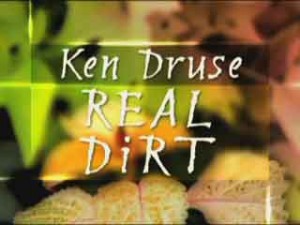Lectures/Classes 2011
August 23, 2010 by admin
Filed under Garden Lectures
The next best thing to gardening is talking about gardening, and I would love to speak to your group! I offer a wide range of presentations for a variety of audiences. Please check my Lectures page for details, and use this Contact form to make further inquiries. You can also visit my listing at the GreatGardenSpeakers.com website, where you’ll find a wealth of details. Here’s my current schedule of upcoming lectures. I hope to see you at one of them!
Wednesday, January 19
When: 8:00 PM-9:00 PM
Where: Chappaqua Library, 195 South Greeley Ave., Chappaqua, NY
Phone: (914) 909-0758 (please restrict calls to normal business and early evening hours)
Lecture: Containers that Won’t Quit
Thank you to the Taconic Gardeners Club for hosting this event.
Wednesday, March 2
When: 9:30 AM
Where: New Canaan Library (Adrian Lamb room), 151 Main St.., New Canaan, CT
Phone: (203) 966-7575 (please restrict calls to normal business and early evening hours)
Lecture: Cottage Gardening
Thank you to the Garden Center of New Canaan for hosting this event.
Wednesday, March 16
When: 6:30 PM
Where: New Milford Public Library, 24 Main St., New Milford, CT
Phone: (860) 355-1191
Lecture: Cottage Gardening
Thank you to the New Milford Public Library for hosting this event.
Saturday, March 26
Connecticut Master Gardener Symposium
When: two sessions, 11:00 AM-noon and 1:00 PM-2:00 PM
Where: Manchester Community College, Manchester, CT
Lecture: Cottage Gardening
For information about cost, please check the Connecticut Master Gardener Association website. Thank you to the CMGA for including me in their program.
Saturday, April 2
When: 2:00 PM
Where: Meriden Public Library, 105 Miller Street, Meriden, CT
Phone: (203) 630-6349
Lecture: Cottage Gardening
Thank you to Meriden Public Library for hosting this event.
Thursday, April 7
When: 12:00 noon
Where: Church of Christ Congregational, on the rotary in Goshen, CT
Phone: (860) 491-9142 (please restrict calls to normal business and early evening hours)
Lecture: Cottage Gardening
Thank you to the Goshen Garden Club for hosting this event.
Thursday, April 21
When: 10:00 AM
Where: Newbury Congregational Church, corner of Rte. 133 and Tower Rd., Brookfield, CT
Phone: (203) 775-8106 (please restrict calls to normal business and early evening hours)
Lecture: Shade Revealed: How to Have Success in Low Light (Really!)
Thank you to the Garden Club of Brookfield for hosting this event.
Tuesday, April 26
When: 10:00 AM
Where: Keeler Tavern Museum, 132 Main St., Ridgefield, CT
Limited to members of the Ridgefield Garden Club and guests
Lecture: Shade Revealed: How to Have Success in Low Light (Really!)
Thank you to the Ridgefield Garden Club for hosting this event.
Saturday, June 4
When: 11:00 AM
Where: Florence Griswold Museum, 96 Lyme St., Old Lyme, CT
Reservations required; fee charged.
Phone: (860) 434-5542, ext. 111
Lecture: Containers that Won’t Quit
Thank you to the Florence Griswold Museum for hosting this event as part of their GardenFest programming series.
Wednesday, June 8
Cornell Cooperative Extension Home Gardening Lecture Series
When: 10:00 AM
Where: The John Jay Homestead, 400 Rte. 22, Katonah, NY 10536
Phone: (914) 285-4640
Lecture: Cottage Gardening
For information about cost, please check the Cornell Cooperative Extension website and click on “Calendar” at the top. Thank you to the Lecture Series coordinators for including me in their program.
Tuesday, October 18
When: 1:00 PM
Where: Barrington Public Library, 281 County Rd., Barrington, RI
Lecture: Cottage Gardening
Thank you to the Barrington Garden Club for hosting this event.
Stop Bugging Me!
August 10, 2010 by admin
Filed under Techniques
When you work outdoors for nine months out of the year, you become very focused on physical comfort. So, while other women may obsess over designer clothes, I have a “thing” for outerwear and work shoes. Let’s put it this way: I won’t be lusting after any Manolo Blahniks until they come out with a waterproof, steel-toed line (although it has occurred to me that those pointy-toed stilettoes lots of women wear might be useful for digging out dandelions).

Hmmm...despite their potential as dandelion weeders, I won't be wearing these in the garden any time soon!
Generally, being comfortable means finding clothes and accessories that keep you dry, at a suitable temperature, and free of bites and scratches. Today I’m going to share with you one of the things I do to take care of that last bit: come home from work without being covered with welts from the thousands of insects that want a piece of me every day.
Insect bites anywhere are annoying, but what really gets to me is when hundreds of tiny bugs swarm around my face. When it goes on hour after hour, it’s enough to drive me crazy, so I really need something to keep the little bloodsuckers away from my mug!
Like a lot of people, I don’t like to use Deet-based bug repellants. For one thing, I hate the smell of Deet. For another, I’d have to have it on practically every day, and that’s a lot of exposure, even if I apply it to my clothes and not my skin. I’ve tried Deet alternatives, but unfortunately I have to say that Deet is the only thing I’ve ever found that actually keeps bugs at bay. But I do have a trick up my sleeve, and you might want to try it, too.
You need to start with a sturdy, wide-brimmed hat. This is one of those things in life worth its weight in gold, and just about as hard to find as a real gold hat since people stopped wearing hats as a part of their everyday attire. I can’t help you find the hat, although I can tell you where I bought the one I’m currently using. There’s a women’s clothing company called Coldwater Creek, and occasionally they carry really sturdy “straw” hats very suitable for use in the garden. A couple of summers ago I found one for about $8 in their outlet store, and I bought two. I’m still using the first one, and I have the spare stored away for when the first one gives up the ghost (which doesn’t promise to be any time soon, incredibly).
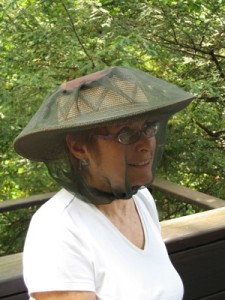
My neighbor, Alice, modeling my hat rigged to keep bugs at bay. Thanks, Alice!
The hat has a wide brim, and the brim is thick. Although the hat is flexible, the brim is sturdy enough to resist a little bit of pressure. It also has a real hatband to absorb sweat. That’s what you’re looking for in a hat.
Next, you’ll need this item: a mosquito head net. I bought mine in the sporting goods department at a local Wal-Mart. Other places where you can probably find a similar item include sporting good stores, K-Mart, Target or any other discount retailer. I think they’re actually made for hunters, hence the “camouflage” pattern you’ll see if you follow the link above.
Use a safety pin to secure the net to the crown of the hat and then pull it down over your face. It only extends down to about the clavicle, so you may need to wear a lightweight shirt that buttons up to the collarbone to keep bugs from biting you below the neck. It works best to pull the net down over your collar, not the other way around. This summer, though, when the temperatures have topped 85 degrees F (30 degrees C) for weeks and I’ve been working with as little clothing on as possible, I haven’t had a problem with bugs biting my neck. They just collect on the outside of the net, where the wide hat brim holds them far enough away from my face to allow me to work without having to slap insects away constantly. This setup is a godsend for me.
So there you have it: my “hat trick.” For the cost of a topper and a few bucks in netting, without using any bug repellants, you can keep insects away from the most vulnerable part of your body. If you try it, let me know how it works for you, and it would be great if you would share your own methods for foiling flying, biting things. Take that, bugs!
Saturday, July 3
June 29, 2010 by admin
Filed under Garden Open Day
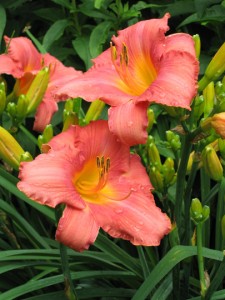 For the last few years I’ve heavily publicized an “open garden” day at my display garden the first week of July, but this year work has been so demanding I’ve had no time to plan an event. Instead, I’m just posting this notice here and putting up a few local signs to let interested gardeners know that I’ll be on site at the garden from 9:00 AM until noon on Saturday, July 3, rain or shine.
For the last few years I’ve heavily publicized an “open garden” day at my display garden the first week of July, but this year work has been so demanding I’ve had no time to plan an event. Instead, I’m just posting this notice here and putting up a few local signs to let interested gardeners know that I’ll be on site at the garden from 9:00 AM until noon on Saturday, July 3, rain or shine.
This is the same garden that was featured in the May, 2010 issue of Horticulture magazine. Despite a few losses in the wake of last year’s water-soaked weather, the garden is looking good. A tad dry, but at least not mildewed! Daylilies, astilbes, various bee-balms and many other plants will be reaching their peak, so there’ll be no better time to see it all year.
If you find yourself in the vicinity of Sherman, CT on July 3, please take a moment to stop by. The garden is located next to the Sherman IGA market in the Sherman Green Marketplace on Rte. 39 North just north of Rizzo’s Garage and the firehouse currently under renovation. For more information, you may call (860) 350-3565 (not after 9:00 PM, please) or email me through my Contact form. I hope to see you there! Until then, here are a few photos from previous years to pique your interest.
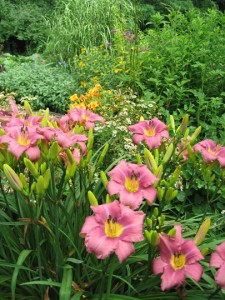
A section of the border, with daylily 'Chicago Princess' in the foreground
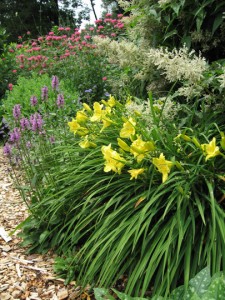
Daylily 'Happy Returns' with bee-balm, betony and catmint for companions
My Podcast Debut
May 11, 2010 by admin
Filed under In the News
The other day, I reached one of those milestone moments: my first time participating in a podcast. I was honored to chat with garden guru Ken Druse for his online program Real Dirt. If you haven’t listened to Real Dirt before, you’ll want to check it out. Ken talks with people from all corners of the horticulture world and touches on all manner of subjects interesting to gardeners.
My talk with Ken is the second half of the May 7, 2010 show. We discuss cottage gardening, personalizing outdoor spaces and the payoff gardeners get from improving their soil. Scroll down and you’ll find lots of other fascinating people, plants and garden projects Ken has brought to his audience. He and I would both appreciate it if you’d please visit, listen and comment.
Featured in Horticulture
April 19, 2010 by admin
Filed under Cottage Gardening
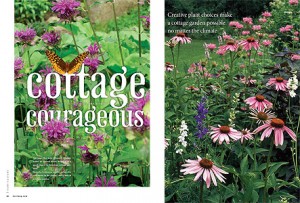
All you Horticulture magazine readers out there may already have noticed a certain familiar cottage garden in the May issue. Yup—that’s my baby, the same garden I showcase in my Connecticut Cottage Garden lecture, and the same one you’ve seen here in some other posts under the Cottage Gardening heading.
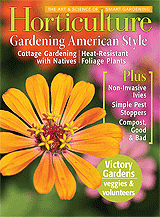 Writing the article was a good exercise for me, because it forced me to focus and condense all the ideas I want to convey about cottage gardening into a few broad principles, which themselves all boiled down to one overarching piece of advice: use the plants that are best suited to your climate, your available time, energy and budget, and your specific site. Sometimes you can only discover what those are by trying something out, but most of the time it’s pretty predictable what will work and what won’t.
Writing the article was a good exercise for me, because it forced me to focus and condense all the ideas I want to convey about cottage gardening into a few broad principles, which themselves all boiled down to one overarching piece of advice: use the plants that are best suited to your climate, your available time, energy and budget, and your specific site. Sometimes you can only discover what those are by trying something out, but most of the time it’s pretty predictable what will work and what won’t.
The basic problem is that you can’t take the traditional English cottage garden plant palette, plunk it down wholesale in the Northeast and expect it to work. As I often say, England and New England may have a name in common, but when it comes to gardening the resemblance is strained.
The English climate (although of course it varies) is milder, cooler and more predictable than ours, which makes their plant palette more extensive. There, many plant diseases are easier to control precisely because the English climate is not as conducive to their development. And for the love of Pete, they don’t even have Japanese beetles! It really is easier to garden there!
One subject I cover in the article that I haven’t broached yet in this blog is the idea that you’ll save yourself a lot of unnecessary heartache, not to mention time and money, if you don’t get too hung up on growing traditional cottage garden plants if they just don’t do well here, for whatever reason. Instead, look for reasonable substitutes that are reliable.
Here’s one example. Early in my cottage garden’s history, I planted a number of reblooming shrub roses. Bad idea. Not only were they Japanese beetle magnets, but they also had a hard time fending off their neighbors. I intentionally included a lot of large, leafy perennials in my cottage garden because their height and mass give the space privacy and separation from some busy surroundings. All well and good, but everyone knows roses don’t like crowding. They suffered, and eventually I removed them.
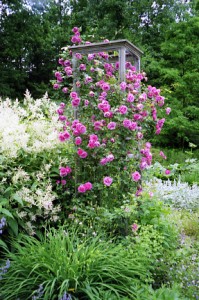
Rosa 'Cl. American Beauty' living up to her name.
But one rose remained and has been a highlight of the garden right from the start. Ironically, it was moved there from another garden where it wasn’t getting enough light. While the other roses declined, it found its stride and developed into a stunning specimen. It’s a ‘Cl. American Beauty,’ and you can see in the photo at left how impressive it can be.
So what made this one rose different? Several things. First, it’s a climbing rose. I grow it on an 8′ tall cedar pillar with hardware cloth sides. Grown that way, most of its foliage is up above the plants that surround it instead of struggling to grow out from underneath. Plus, the open structure of the pillar promotes air circulation, which discourages disease.
Second, it’s an early flowering, once-blooming rose. Your first reaction might be disappointment, but it shouldn’t be. It’s true that this rose will bloom for a shorter time than reblooming roses. However—and this is an important however—it blooms during the first three weeks of June, before the Japanese beetles emerge! I may get only three weeks of flowers, but I get three weeks of perfect, unmolested flowers with no nasty holes gnawed into the buds. I’ll take that any day over months of half chewed, pesticide soaked flowers on rebloomers.
It should go without saying that ‘Cl. American Beauty’ is naturally quite disease resistant and cold hardy in Connecticut. You should always select perennial and woody plants for cold hardiness and disease resistance.
Now, some of you might say that a once-blooming rose isn’t an alternative to a traditional cottage garden plant—it is a traditional cottage garden plant! And you’d be half right. Although ‘Cl. American Beauty’ is a cross introduced in the early 1900s, it has more in common with truly old roses than it does with most modern ones. The point is that a lot of gardeners either might not know or might not make the time to find out what kind of rose is most likely to succeed in a given garden. They’d just go to a nursery and pick one they liked. That’s understandable, because it’s easy to have your socks knocked off by some trendy plant fresh from the grower looking better than it ever will again because of all the protection, coddling and extraordinary care it’s received. Can you give it that same level of care? Probably not. Better to choose something that doesn’t need all that extra care.
My ‘Cl. American Beauty’ doesn’t need to be sprayed with fungicides, and it doesn’t require that I take any measures against Japanese beetles. Oh, and by the way…its fragrance is heavenly! As roses for cottage gardens go, I couldn’t ask for more.
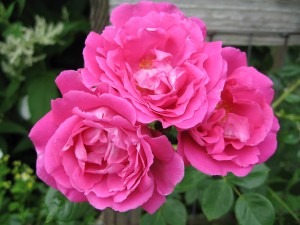
Mansfield, CT
April 18, 2010 by admin
Filed under Garden Lectures
Now that the weather has warmed and everyone’s come out of their winter hibernation, I’m having a ball giving presentations to gardeners around the region! If you’d like to have me speak to your group about cottage gardening, shade gardening or any other subject, please let me know by clicking on this Contact form. For a list of all the shows I’m currently giving or creating, look here. If you don’t see what you want, just ask—I’m always happy to craft a custom show to accommodate particular interests. Finally, check my Lecture Schedule page for news on upcoming presentations, and thanks to all who invited me to speak in the past!
Next lecture:
A Connecticut Cottage Garden: Adapting a Classic Garden Style to New England
Friday, May 14
When: 7:00 PM
Where: Mansfield Public Library, 54 Warrenville Rd., Mansfield Center, CT
Phone: (860) 423-2501
Danbury, CT
April 14, 2010 by admin
Filed under Garden Lectures
Now that the weather has warmed and everyone’s come out of their winter hibernation, I’m having a ball giving presentations to gardeners around the region! If you’d like to have me speak to your group about cottage gardening, shade gardening or any other subject, please let me know by clicking on this Contact form. For a list of all the shows I’m currently giving or creating, look here. If you don’t see what you want, just ask—I’m always happy to craft a custom show to accommodate particular interests. Finally, check my Lecture Schedule page for news on upcoming presentations, and thanks to all who invited me to speak in the past!
Next lecture:
A Connecticut Cottage Garden: Adapting a Classic Garden Style to New England
Friday, April 16; PRE-REGISTRATION REQUIRED
When: 11:00 AM
Where: Danbury Museum and Historical Society, 43 Main St., Danbury, CT
Phone: (203) 791-8952 (please limit calls to normal business hours)
The Danbury Garden Club is hosting this event. Non-members are welcome to attend for a $5 fee.
Farmington, CT
March 14, 2010 by admin
Filed under Garden Lectures
Off-season? There’s no such thing! Winter is when I get a chance to do one of my favorite things: meet other gardeners and share with them what I’ve learned through the years gardening for myself and my clients. If you’d like to have me speak to your group about cottage gardening, shade gardening or any other subject, please let me know by clicking on this Contact form. For a list of all the shows I’m currently giving or creating, look here. If you don’t see what you want, just ask—I’m always happy to craft a custom show to accommodate particular interests. Finally, check my Lecture Schedule page for news on upcoming presentations, and thanks to all who invited me to speak in the past!
Next lecture:
A Connecticut Cottage Garden: Adapting a Classic Garden Style to New England
Tuesday, April 13; PRE-REGISTRATION REQUIRED
When: 7:00 PM
Where: Farmington Public Library, 6 Monteith Dr., Farmington, CT
Phone: (860) 673-6891
Do You Want to Know a Secret?
March 3, 2010 by admin
Filed under Bulbs, Spring Bloomers
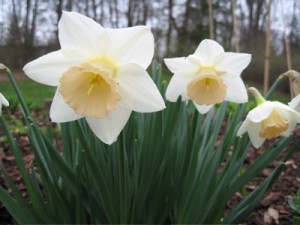
In an impossibly few short weeks, we’ll all be seeing a lot of these: daffodils. That’s why I thought it would be a good time of year to let you in on a little secret. I’m not talking about garden intrigue; this isn’t the kind of secret anyone keeps intentionally. It’s just a little fact about daffodils (and other spring-blooming bulbs) that even experienced gardeners often don’t know.
But let me start at the beginning. A lot of people ask me about growing daffodils because deer and other animals don’t browse them. Unlike tulips, which are a favorite food of both deer and a number of rodents, daffodils produce chemicals that are highly toxic, and animals instinctively avoid eating them.
Daffodils are extremely easy to grow as long as their basic needs are met, and their number one need is sun—at least six hours a day of it for large-flowered daffodils like the one pictured above.
The biggest mistake I see people making with daffodils is placing them in too much shade. One reason people get confused about how much shade daffodils (or any other bulb) can take is because the first year after planting, they always bloom beautifully, even if planted in significant shade. That leads people to think they’ll continue to bloom in shade year after year. Unfortunately, except for a few small species daffodils that are far less demanding than the large-flowered types most people want to grow, they won’t.
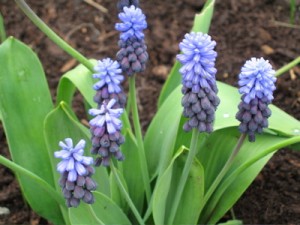
Grape hyacinth (this one is Muscari latifolium) is another spring bulb that does best with plenty of sun.
Just about all spring bulbs (there might be an exception or two, but I can’t think of one) produce their flower buds the year before they open. That means that the buds for the daffodils that will bloom in a few weeks formed last spring and summer. As soon as the daffodils finish blooming this year, they’ll start producing the buds that will open next year. You won’t see those buds, however, because they’ll be hidden down in the bulb and they’ll remain there until next spring.
So, when daffodils are planted in shade and bloom well the next spring, that’s because the buds to produce those flowers were developed and ready to burst into bloom before they were planted. (And I guarantee that the bulb grower raised them in lots of sun!) However, once planted in shade, those daffodils won’t be able to produce as many flower buds for the following year because there’s not enough light available to them. Over the course of three or four years, they’ll produce fewer and fewer buds until they do nothing but put up leaves and an occasional flower. So, if you have daffodils that do that, it’s because they’re growing in too much shade, and the only way to get them to flower well again is to move them to a sunnier spot. Fertilizer will not help with this problem because the problem isn’t a lack of nutrients—it’s a lack of light.
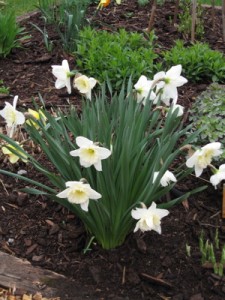
A clump of Narcissus ‘Ice Follies’ blooms well again after several years of “sun therapy.”
After a few years growing in more sun, daffodils will recover and start flowering again. Actually, the daffodils in the picture at left were moved from a spot too shady for them about four years before the picture was taken, and you can see how well they bounced back.
If you remember, I said that large-flowered daffodils need full sun. Species daffodils are more shade tolerant. Being so much smaller, they don’t need as much solar energy to produce flower buds for next year, but they’re still not shade loving plants. Give all daffodils as much sun as you can, and use bulbs such as Siberian squill (Scilla siberica), snowdrops (Galanthus spp.) and crocus (Crocus) where light levels are low. These plants are much better adapted to shade.
So, the secret is out. Remember that a spring bulb won’t show the effects of a deficit of sun (or nutrients, for that matter) until the year after the problem occurs. Given what they need, all hardy bulbs have the potential to return and beautify your landscape for many years to come.
Winter Is Wonderful
February 9, 2010 by admin
Filed under Seasons in the Garden, Winter
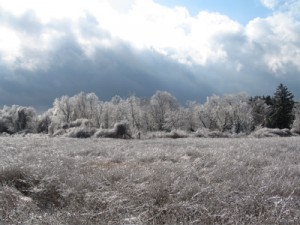
Every time I give a winter lecture (like the one I presented at the Berkshire Botanical Garden in Stockbridge, MA the other day), I can always count on several people saying, “You must be champing at the bit for spring to arrive!” Well, actually…no, I’m not.
It’s not because winter is my “off season” when I get a chance to rest and recharge. The fact is, every season is incredibly busy for me, including the coldest months. And it’s also not because I’m an avid (if only marginally talented) skier, although I admit to eying slopeside cabins in the Canadian Rockies as ideal retirement property.
I’m a four-season kind of person, which is why I live in a part of the world that’s supposed to get four distinct seasons. I have an interest in all kinds of flora and fauna, but I’m especially fascinated by the plants and animals that live where conditions are in a constant state of change. Winter is an integral part of that change, and I’m always a bit surprised by the dislike other people express for this beautiful, important season, and especially for the snow that should come along with it.
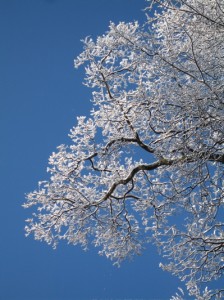
An early December storm left these branches traced in snow.
Gardeners in the Northeast should love winter and snow, for a lot of reasons. First, if we didn’t have winter, New England wouldn’t be New England. There’d be no sugar maples, no white birches, and no apple crop in autumn. We wouldn’t even have the stone walls that famously crisscross our landscape, because it’s the freeze/thaw cycle that brings rocks to the surface, where farmers have to remove them from fields.
As for snow, its importance just can’t be overstated. The day after Thanksgiving, I say, “let it snow and keep on coming.” I don’t want to see the ground until April, and I can guarantee you that the plants are with me on that one. A nice thick layer of protective snow is just the insulation they all need.
Longtime gardeners eventually begin to notice patterns—events that occur regularly, if not always cyclically. One of the recurring patterns in the Northeast is the winter where nearly every individual of a particular type of plant dies. The discovery is made in spring when gardeners begin to chat with one another about what did and did not “come back.”
This often happens with plants that are at the northern edge of their growing range in the North to begin with, such as butterfly bush (Buddleia). In Zone 5, it’s considered perfectly normal for butterfly bush to die back to the ground, even though it’s a woody plant. When a plant is living on that edge, it doesn’t take much in the way of stress to push it over the cliff.
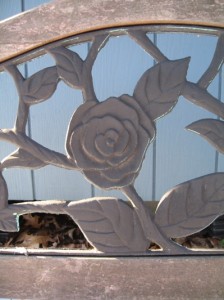
I have a "rosy" view of winter...
Interestingly, though, it also sometimes happens with plants that are hardier overall, such as sweet autumn clematis (Clematis maximowicziana). It isn’t always obvious what happened to cause these widespread losses, but I think it’s safe to say that when the majority of all the sweet autumn clematis plants in a region die one winter, it’s probably because of some large-scale environmental factor.
All you can do is take an educated guess at the reason for these events. Things plants generally don’t like include temperatures below freezing and blasts of Arctic wind without snow cover, and rapid changes in temperature, particularly when they swing around the freezing point (15°F one day, 50°F the next). People might like mid-winter thaws, but warm interludes in what should be a cold season generally just confuse and weaken plants. A lack of snow just makes them more susceptible to damage when temperatures inevitably drop again. Gardeners shouldn’t take it too personally when these deaths occur; they don’t imply failure of the gardener.
So, I’d like to respectfully suggest that gardeners should have a higher opinion of winter and snow! Yes, snow also has its down side—for one thing, rodent damage to plants can be worse in very snowy winters—but on the whole, it’s immensely beneficial, and it’s free. If that doesn’t warm the cockles of a New Englander’s heart, I don’t know what will!

A winter reading gem: Bernd Heinrich's Winter World
Recently, I discovered a wonderful book that celebrates winter and snow in an engaging way: Winter World: The Ingenuity of Animal Survival by Bernd Heinrich. Although this is a little off the topic of gardening, it’s not at all off the topic of why a lot of people garden: a love of the outdoors. In the wrong hands, a topic like the mechanics of winter survival could be dry and uninteresting. But in Winter World, one man’s love of land and the plants and animals that occupy it makes the subject come alive. Heinrich traces the web of connections between animals and plants, and every gardener should be interested in that.
It’s all too easy for gardeners to fall prey to the fallacy that gardening is about shaping the natural world to our liking. If you allow yourself to think that, nature has a way of eventually showing you that you’re not really in control. I prefer to see gardening as a tool for learning about the processes of the natural world and especially how plants and animals interact. The puzzle of these interactions is one of the greatest stories that could be told, and winter is a big piece of it.
Read Winter World and you’ll gain a greater appreciation for how contradictory individual plant and animal life is, simultaneously tenuous and tenacious. It may help impatient gardeners live a little more in the moment of winter instead of wishing for it to end, and it’s definitely something worth pondering as Earth’s quietest season ticks by.


